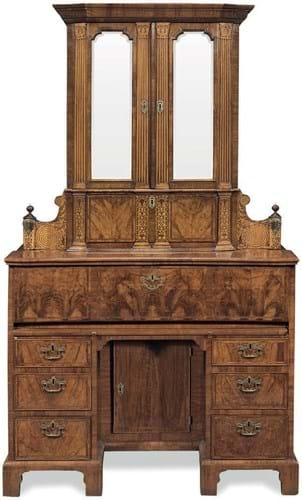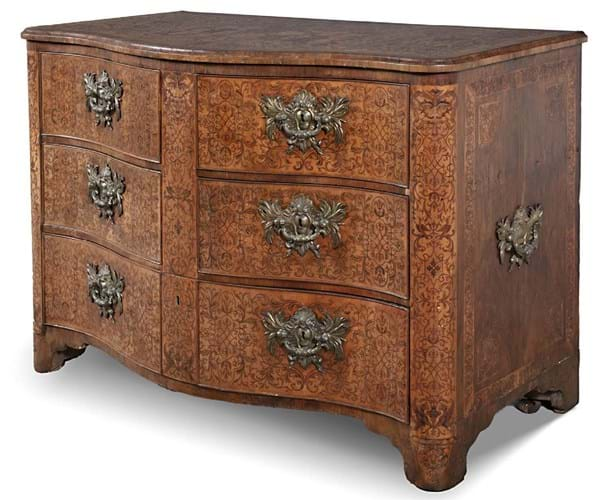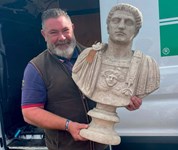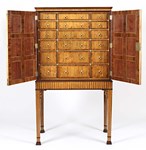The Blessington Commode, considered the masterpiece of the enigmatic German-Irish cabinetmaker John Kirkhoffer, had been estimated at €100,000-150,000 as part of the Country House auction held by Adam’s at Townley Hall, County Louth on October 9-10. The price paid by the museum has not been disclosed.
It was the renowned furniture historian and collector RW Symonds who first posited in 1956 that a curious group of early to mid-18th century ‘continental’ cabinets with seaweed marquetry inlay had an Irish origin.
In 1997 the Irish furniture specialist Desmond Fitzgerald, Knight of Glin, conclusively demonstrated that this was indeed the case - concluding that they were supplied by the same workshop in Dublin. However, it was not until 2007 (shortly after the publication of the seminal work Irish Furniture by Desmond Fitzgerald and James Peill) that a name emerged. This was John Kirkhoffer, whose signature and the date 1732 was found on a desk in the Art Institute of Chicago.
Kirkhoffer (his name appears in different spellings) was probably the son of Franz Ludwig Kirkhover, who arrived in Ireland as a refugee in 1709 after escaping the war-torn Rhineland-Palatinate area. It is estimated that 800 German Protestant families came to Ireland.
The Kirkhoffer family of cabinetmakers and inlayers made it to the counties of Kerry and Limerick before ultimately settling in Dublin. John Kirkhoffer is recorded there in the early 18th century, running a workshop that lasted into the 19th century. The Blessington Commode shares the same Berainesque marquetry inlay as other pieces in Kirkhoffer’s growing oeuvre.
Dated to c.1745, the top is inlaid with the arms of the Anglo-Irish peer William Stewart, Earl of Blessington (1709-69). He and his wife Eleanor FitzGerald of County Cork were considered among Dublin’s most fashionable couples, living in Henrietta Street and a great mansion house at Blessington, Co Wicklow, that was razed in the 1798 Rebellion. Stewart (previously Viscount Mountjoy) was created Earl of Blessington on December 7, 1745, perhaps the opportune moment to commission a suite of furniture emblazoned with his new title.
Adams’ managing director James O’Halloran called it “perhaps the single most important piece of mid 18th century Irish furniture to come to auction in decades” while his colleague Stuart Cole, who had known the commode for a number of years, described it as “the most inlaid piece of Irish furniture I’ve ever seen”. It had last sold at Christie’s in 1996 when, sold as an Irish commode bearing the Blessington arms.
“When we knew the piece was coming in for sale, we gave advance notice to several institutions” Cole told ATG. “Too often they are the bridesmaid and not the bride when it comes to buying at auction, but in this case [the NMI} moved swiftly, sent in conservators and consultants to make reports and confirmed their interest. When the vendor [a Dublin private collector] realised where the piece might end up, they were happy to receive a pre-sale offer. “
By the time of the viewing at Townley Hall the commode was displayed with a sign saying it had been sold. It is thought to be the first piece by the maker in the NMI collection.
A spokesperson for the National Museum of Ireland told ATG it “does not normally discuss the costs of any acquisition” but described the commode as “a significant addition to the museum’s collection of 18th century Irish furniture”. It added: “Continental in style and made of Irish materials, for the first Earl of Blessington, it is representative of the rich cultural life and booming economy of Dublin’s Georgian period. The National Museum of Ireland does not currently hold any work by Kirkhoffer and as such this was an important acquisition for the national collection.”

The George I walnut and marquetry secretaire cabinet c.1725, attributed to John Kirkhoffer that sold for £18,000 at Bonhams.
This is the second piece of Kirkhoffer furniture to be offered for sale this year - and both have gone to Irish institutions. A George I walnut and marquetry ‘architectural’ secretaire cabinet, c.1725, attributed to John Kirkhoffer was part of Bonhams’ Connoisseur’s Library sale in Knightsbridge on February 7-8. Estimated at £20,000-30,000, it sold for £18,000 (£22,950 including premium) and was donated by benefactor David Boles to the Irish Museum of Time in Waterford.
It is one of four similar cabinets (all pictured in Irish Furniture) that include the example in Chicago and another in the V&A reputed to have belonged to Jonathan Swift (1667-1745).
















